I am pleased to share this email interview with the painter Barbara Grossman. Last fall she gave me her delightful catalog, “Patterning Women”, from her July 2023 show at the Bowery Gallery. I wanted to find out more about her background, process and thoughts about artmaking so I asked her for this interview. I would like to thank her for her thoughtful answers to my questions. Since the 1980’s she has been making broadly painted artworks with a subject of invented interiors decorated with richly patterned floors and walls that flatten the space and harmonize with the groupings of women wearing patterned outfits. Andrew Forge has written of Grossman’s work, “It is what happens between the figures and the patterns that matters.”
Barbara Grossman is an American artist living & working in New York who has won several Awards: Fulbright Hayes Grant, Ingram Merrill Foundation, Connecticut Commission on the Arts, Ranger Prize (Nat’l Academy), Member National Academy of Design. Grossman has taught at Yale School of Art, Univ. of Pennsylvania, New York Studio School, Chautauqua Institution, Mt. Gretna School of Art, and more. She is represented by the Bowery Gallery in NYC and has exhibited widely.
Larry Groff: What inspired you to become a painter?
Barbara Grossman: It was not a matter of being ‘inspired’ but a way of being. As an only child with limited means much of my time was spent drawing with crayons or pencil. Fortunately, I went to the High School of Music and Art in NYC and that pretty much confirmed it for me. It came to me naturally that I was going to make art one way or another.
LG: What was your experience like as an art student? Could you share an important lesson from that time that remains crucial to your work today?
Barbara Grossman: Going to Cooper Union was another path toward my life as a working artist. Cooper was pretty straightforward; you took many classes in the visual art disciplines and worked hard, very hard. Many lessons were absorbed, but being rigorous in one’s field and not expecting rewards in the foreseeable future seemed to be at the forefront of what to expect.
LG: As a founding member of the Bowery Gallery since 1969, could you describe the early years? How did it come about? Who were some of the notable painters exhibiting there at the time, and what has sustained the gallery’s success for so long?
Barbara Grossman: The Bowery Gallery was a rag-tag group of young artists committed to their work. For us, missing was the opportunity to exhibit, so we provided ourselves with a venue, a derelict storefront on the Bowery. That allowed us to be a community and share our work with other artists. We were passionate, and sometimes we got pretty aggravated with each other, arguing about the better kind of painting/sculpture and who exemplified that ideal. We were all basically unknown, except to one another, and only got some recognition after years of exhibiting. The ethics and respect for each other, as well as the opportunity to exhibit, has been a thread that has held the gallery together for 54 years.
LG: Did your studies traditionally focus on figurative painting, working from models and observation? How has this influenced your current work?
Barbara Grossman: I worked directly from models, thus observation, from the time I graduated from Cooper until about 1980. However, figuration was not always my primary focus. There was a public drawing group on 14th St. & 6th Ave. that I went to several nights a week. I met a lot of artists there, including a few of the original Bowery members. My interest in the figure was steadfast, but it always included the environment in which the model resided. I would say that my current work is an evolution of my early work. The urgency of the human figure is still present, plus many other concepts and visual components that I now feel compelled to include.
LG: Matisse’s paintings seem to have had a significant influence on your work. Who are other painters who have greatly inspired you?
Barbara Grossman: Yes, Matisse has been a large influence throughout my career, but I spent almost a year copying Piero della Francesco, which I am sure was profound at the time. Others who have influenced me are Bonnard, John Graham, DeKooning, Soutine, Giacometti, Cezanne, Indian and Persian miniatures and often installation art. In more recent times Mondrian and contemporaries such as, Pat Pasloff, Brice Marden, Ruth Miller, Harriet Korman, Juane Quick to See Smith, and artists like Dana Schutz and Amy Sillman whose journeys and inventions are not predictable. Thus, the worlds they make are intriguing to me.
LG: You’ve mentioned, “I think in color. Color and light are one.” Could you explain how this philosophy shapes your artistic process and compositions?
Barbara Grossman: That is a hard question to answer simply because the experience of color and light is inherent in my vision. It is not necessarily a philosophy alone but the way I believe I perceive the world. So, in my process, I try to incorporate light and color simultaneously as I make a picture. It is part knowledge, part visual, and part feeling that one is experiencing at any moment. Synergy might be a way to summarize the apprehension.
LG: In John Goodrich’s essay, Lightfall, Location, Gravity, for your latest exhibition catalog, he notes your view of naturalistic rendering as a “trap.” Could you elaborate on this perspective?
Barbara Grossman: It seems that ‘naturalistic rendering’ is distant from direct or imagined perception. It is purely conceptual and limited to an idea. When making a space that contains many things, one has to be open to any and all possibilities that will form the invented image. I want to bring it to life to the viewer so it becomes believable and ‘real’. Preconceived methods are not personal or formative.
LG: Your work emphasizes the flat picture plane, avoiding traditional perspective and tonal gradations. How do modernist notions of flatness and respecting the picture plane’s integrity benefit your work compared to conventional spatial illusions?
Barbara Grossman: That is true; the picture plane is skewed. I believe it is another way to present ‘near and far’ without the conventions of perspective, which is a concept and not at all how we human beings see. Tonal gradations are also a preconceived notion about how light falls on objects, planes or figures. Each painting is a new event. It is my experience that viewing a painting that offers this way of seeing is as convincing, if not more, than the traditional ‘spatial illusions.’ I believe that the known ways of describing are predictable and lifeless for the most part. Perception is more complicated because the eye and the mind are never at rest, so apprehending a space takes the constant motion of the eye. It is the interstices that brings a painting to life. When putting those moments of vision on a flat surface, one has to be in tune with that physical time-based experience. Everything is in flux until one ‘nails it’ to the canvas or paper.
LG: Your recent travels in Morocco and Turkey seem to have influenced your work. What prompted these journeys, and could you describe any impactful moments that inspired your paintings?
Barbara Grossman: I have been fascinated by the artifacts and designs in tiles and architecture in the Near East and how they compress space, for a long time. I think it may have started with an interest in textiles. So, my recent trips to Morocco and Turkey were on my mind for some time. Being in such places was a thrill as it confirmed my sense that these were unique constructions for people to inhabit. In Istanbul, I discovered a modest-sized but spectacular Mosque hidden behind the Egyptian bazaar, which captivated all I had been feeling and dreaming about for years. Hours of drawing and being immersed in that space have given me a lifetime of ideas. It makes me want to paint images that viewers might want to enter.
LG: It appears that patterns in your paintings are less about defining perspective or precise geometry and more about creating a decorative repetition of color shapes. How does this approach facilitate movement through the painting and accentuate color harmony and design?
Barbara Grossman: Patterns are there to define the space and to figure out how it works in each particular situation. The geometry and repetition express and/or exaggerate that for me. This is a kind of all-over visual stimulation that I believe carries the eye throughout the painting. The color, figures, and accoutrements participate in the movement as they become one. The decorative is the harmony; it is never about perspective. That is the sensory and the tension that I want to achieve.
LG: Could you share more about your painting process? What factors influence your choice between using a brush or an oil stick? Do you use R&F Oil Pigment Sticks?
Barbara Grossman: Yes, they are R&F Oil Pigment Sticks. They are thick drawing tools that happen to have color as well. But because it is mostly linear, I think of them more as a drawing. There is no conscious choice between painting or drawing per se; it is about the immediacy and scale of what I feel like doing at the moment. For example, if I am testing an idea, I might start with a paper. Or, I might start a painting and, in trying to figure out what I am doing, go to oil stick for a quicker outcome. Paintings are started in a very direct manner. I mix up a few colors, maybe 5 or 6, using thinnish paint on the brush, and draw what I want in the color that it could be. I continue to paint with a kind of openness that may or may not stay on the canvas. I erase a lot with solvent. There are many layers over time. I redraw as I paint. I scrape and wash down paint so I can re-see the whole. So I keep going for as long as it takes, sometimes a year or more. The painting usually tells me when to stop, usually.
LG: Do you predominantly work from invention and memory, or do you utilize drawings or photos in your process?
Barbara Grossman: Almost all of my work is invented. I will use drawing notations that I have done along the way for ideas and for an understanding of how something works in ‘real life’. I think of combinations of things that will end up as part of my compositions all the time. Nature and perception are my sources, even though they may not always appear that way. I rarely use or even consider using photos; it’s just not in my toolbox.
LG: Has there been an artistic idea or belief that you once held strongly but now reject?
Barbara Grossman: Artistic belief? Do you mean something I thought about philosophically rather than practically? I cannot think of something in my actual practice, in the making of paintings, since it has evolved over a long time, but I can think of something that I still ponder. That is Merleau-Ponty’s theory about ‘Cezanne’s Doubt’. Briefly, the notion that his mind was a blank slate receiving impulses from his actual perception seems impossible to me now. From an idealistic point of view, I loved that idea, but it does not seem credible to me, particularly since I did work directly from life for a long time. Transitioning from that experience to working from invention and sometimes memory has convinced me that it is not how humans apprehend their worlds, especially if they want to reproduce their experience on a flat surface, an abstraction.
LG: What are some artistic truths that you believe can only be expressed through painting, and how do you explore these in your work?
Barbara Grossman: I am interested in many visual arts disciplines. Great art goes right to one’s heart and soul. I am also curious about the meaning found in other ways of expression, like music, theatre, film, dance, literature, and even science. I think because painting is inherent in my being, it can affect me in the deepest way, as it is both visual and kinesthetic at once. I think I steal from other forms as they touch my sensibility. It flows when It happens.
LG: Could you name an art book in your collection that you could never part with?
Barbara Grossman: I own a copy of the first book about Matisse in which he chose the work that was printed. Cinquante Dessins, 1921. It was given to my husband, Charles Cajori, as a gift. He took it around to his classes and shared it with his students. Over time, it got worn, so I became concerned since it is not only a visual treasure, it has some monetary value. I had it conserved, and it lives in an archival shell, which I take out periodically and savor with friends. It is a true treasure.
LG: What book are you currently reading?
Barbara Grossman: I just finished Michael Brenson’s biography of David Smith. It is a terrific journey through Smith’s life and work and also a view of the time and other artists he consorted with. It is beautifully written as well. Often, when reading a long nonfiction book, I indulge in a story. The two I read were “Heat and Dust” by Ruth Prawer Jhabvala and “Simple Passion” by Annie Ernaux.

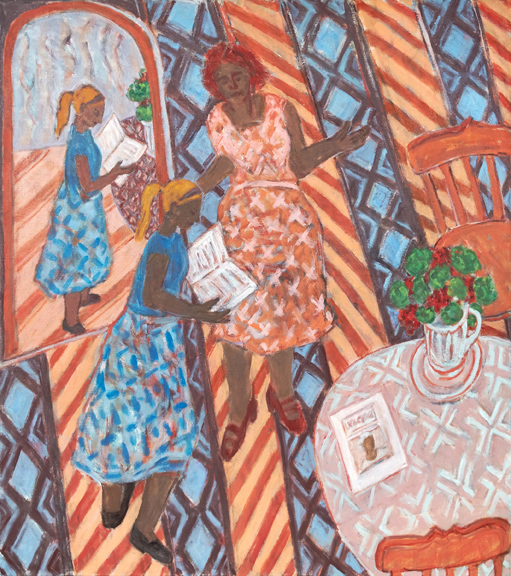
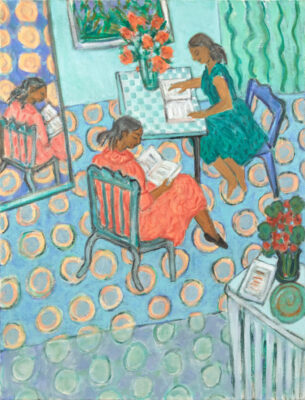
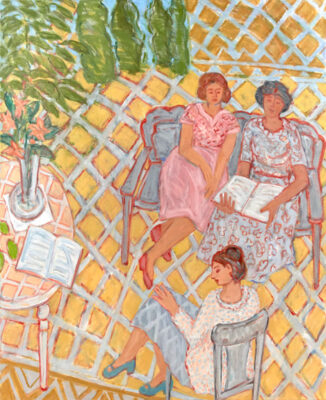
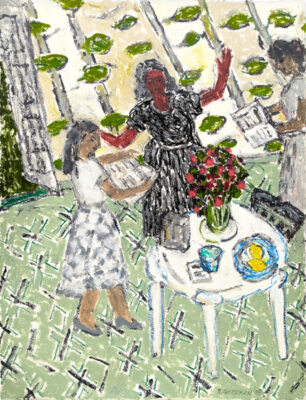
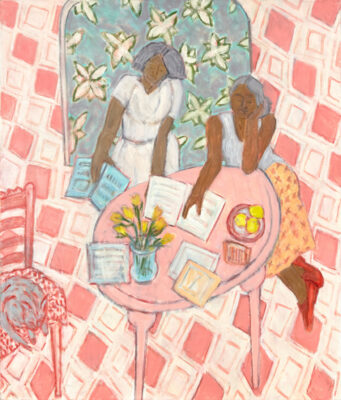
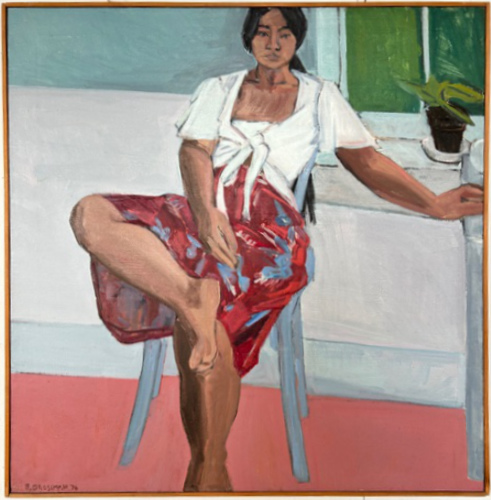
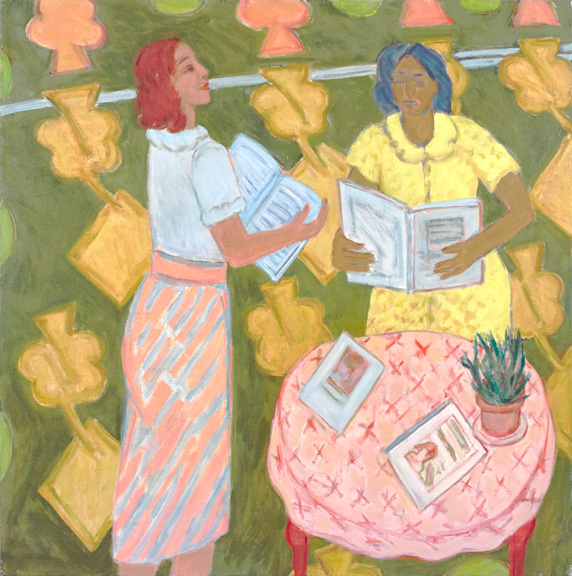
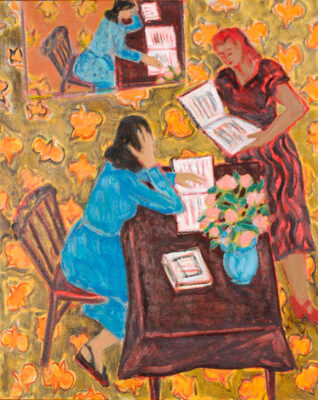
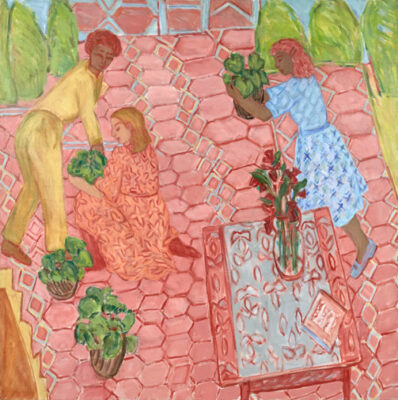
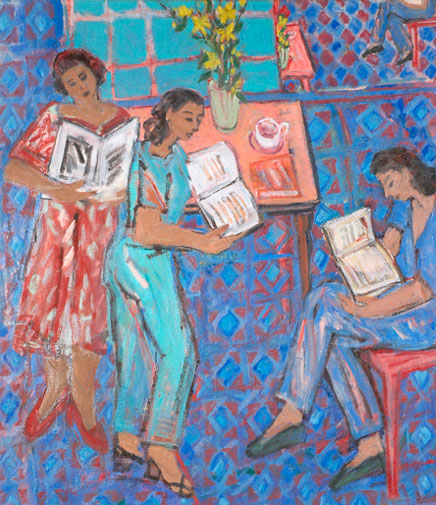
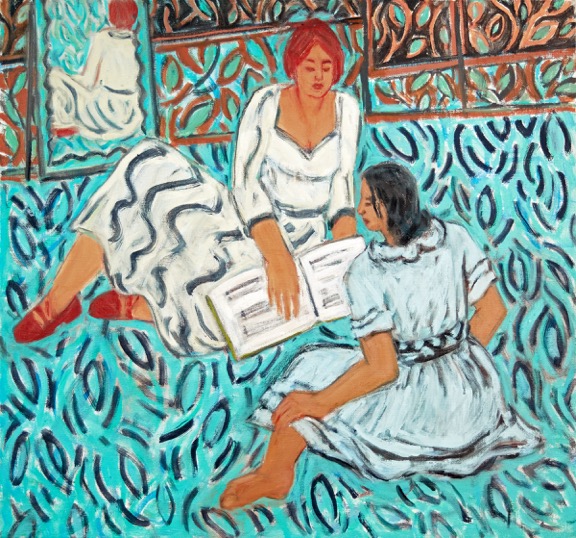
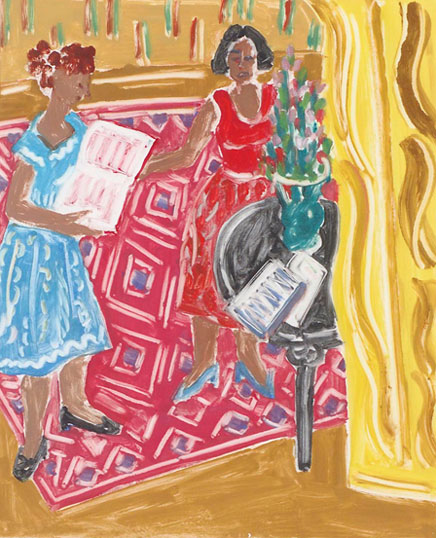
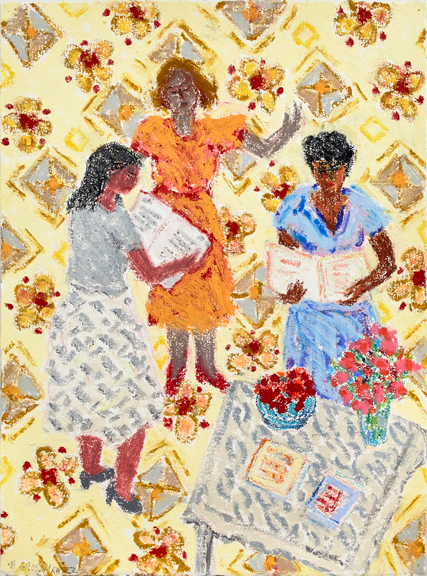
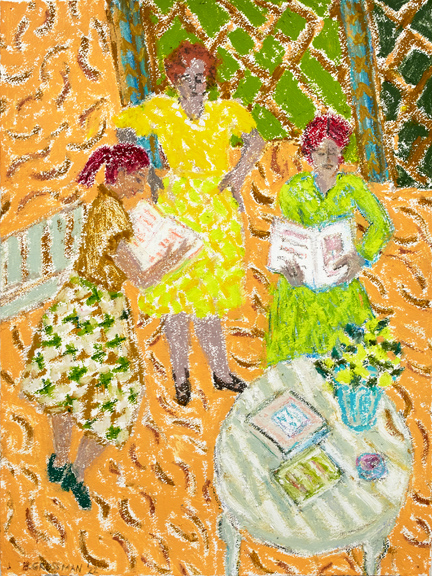
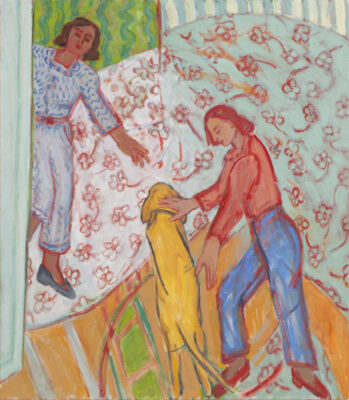





What a wonderful and insightful interview!
Nice interview Barbara, and liking the rest, Celadon Floor and the newest work look fantastic,! E
It’s been valuable to hear Barbara talk about how she works and the concerns that she has about picture space that is figurative yet holds the 2 D nature of the picture plane
Barbara has been a sought after teacher and was an Artist in Residence at Hollins University and she had brought her knowledge of painting to life for her students
I pleased to say that we have a wonderful piece of her work ( as well as a drawing by Cajori )
Barbara remains a key figure in the longevity of the Bowery Gallery as a founding member
Excellent interview. I really enjoyed reading the terrific questions and Barbara’s articulate and thoughtful and thought-proving responses. Also it is a treat to see so many of her works reproduced here with their rich colors, patterns and compositions. Thank you!!
It’s always a treat to read about artist’s processes. Beautiful painting and insightful conversation .
Wonderful conversations about your work. I have always loved the shutter like moments you capture as women engage. You are a living breathing camera!